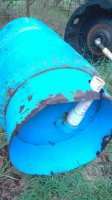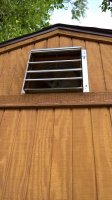TVL
Member
I've decided it's now time to relocate the 30 gallon pressure tank that is underneath the house to outside. The crawl space underneath the house is fairly low and any type tank work would be a real pain in the rear end!
I've purchased a Well-X-Trol 62 gallon tank and want to build a small building that will house ONLY the tank and pressure switch/pressure gauge. The building I plan to build will be 48" X 32" and about 5 feet tall. I plan to stick build the enclosure with 2X4's and T1-11 siding on top of a 5" slab of concrete. I will build it so that the front wall can be removed for ease of servicing.
I want to insulate somehow to prevent freezing in the winter. Here in South Carolina we have about 2 fairly cold months where the temperatures can sometimes drop to the mid teens during the night. But for the most part, we generally have what is considered a mild winter.
1- Insulation is surely a necessity if I want to avoid possible freezing of a line or the tank, BUT will it create issues for me during the summer months? The building will be somewhat sealed and I'm not sure if sweating will be an issue or not?
2- Or, would it be best to wrap ONLY the tank and the exposed PVC piping and do nothing with the walls? In this manner, the tank and piping should be protected from freezing, but during the hot months this type insulation job should also keep the tank and piping from sweating and creating moisture issues in the enclosed building. Does this seem reasonable?
3- Any other ideas or thoughts would be appreciated!
Thanks so much!
I've purchased a Well-X-Trol 62 gallon tank and want to build a small building that will house ONLY the tank and pressure switch/pressure gauge. The building I plan to build will be 48" X 32" and about 5 feet tall. I plan to stick build the enclosure with 2X4's and T1-11 siding on top of a 5" slab of concrete. I will build it so that the front wall can be removed for ease of servicing.
I want to insulate somehow to prevent freezing in the winter. Here in South Carolina we have about 2 fairly cold months where the temperatures can sometimes drop to the mid teens during the night. But for the most part, we generally have what is considered a mild winter.
1- Insulation is surely a necessity if I want to avoid possible freezing of a line or the tank, BUT will it create issues for me during the summer months? The building will be somewhat sealed and I'm not sure if sweating will be an issue or not?
2- Or, would it be best to wrap ONLY the tank and the exposed PVC piping and do nothing with the walls? In this manner, the tank and piping should be protected from freezing, but during the hot months this type insulation job should also keep the tank and piping from sweating and creating moisture issues in the enclosed building. Does this seem reasonable?
3- Any other ideas or thoughts would be appreciated!
Thanks so much!


